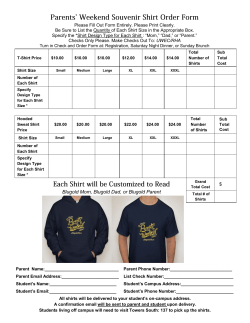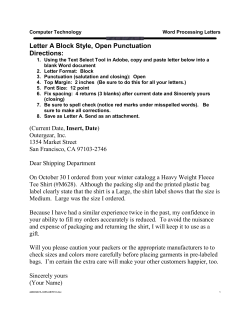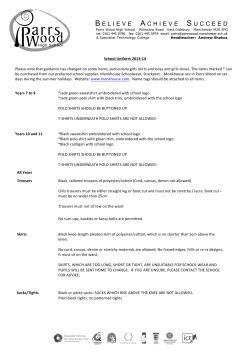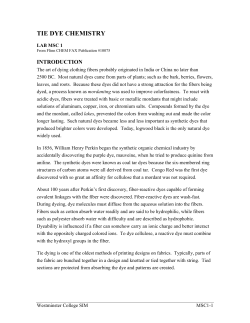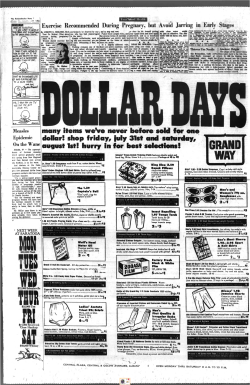
Tennessee Department of Education Task: T‐Shirt Task 8
Tennessee Department of Education Task: T‐Shirt Task 8th Grade Ms. Shaw’s 8th grade class is taking a field trip. The principal has agreed to buy t‐shirts for everyone going on the field trip so that everyone can dress alike. Each person’s t‐shirt will have the school logo on the front, and that person’s name on the back. Ms. Shaw has found two companies that can make the t‐shirts. The costs are listed in the table below. Item Company A Company B T‐shirt and logo $5.75 each $5.65 each (without the name) Letters on the back 3 letters cost $0.63 4 letters cost $0.88 Andrea and Lexus, two students in Ms. Shaw’s class, are arguing over whether Company A or Company B has the best price on the t‐shirts. Andrea believes that Company A will be cheaper because the cost per letter is cheaper. Lexus believes that Company B will be cheaper because the cost of the t‐shirts is cheaper. You are asked to help Andrea and Lexus decide which company to recommend to Ms. Shaw. a) Give an example of a name you can put on a t‐shirt that will make Company A’s price cheaper than Company B. You may use a first name, a last name, or both a first and last name. Explain why Company A’s price is best in this case. b) Give an example of a name you can put on a t‐shirt that will make Company B’s price cheaper than Company A. Explain why Company B’s price is best in this case. c) Which company would you recommend to Ms. Shaw? Make a table of values to support your recommendation. Explain why you chose that company. In your explanation, you will need to tell Ms. Shaw whether you think the t‐shirts should have only the first name, only the last name, or both the first and last names of the students. Include any assumptions you need to make to support your recommendation. d) Use your table of values to draw a graph to represent your data. Do you think the graph would be helpful in supporting your recommendation? Why or why not? e) Develop a formula to help Ms. Shaw determine the price of an individual t‐shirt if she knows the number of letters in a person’s name for the company you are recommending. Teacher Notes: This task requires students to write mathematical arguments. The questions are, to some extent, open‐ended. Answers rely on assumptions made by the students, including using of first, last, or full names and making an assumption regarding the average number of letters in a name. Common Core State Standards for Mathematical Content 8.EE.B.5 Graph proportional relationships, interpreting the unit rate as the slope of the graph. Compare two different proportional relationships represented in different ways. For example, compare a distance‐time graph to a distance‐time equation to determine which of two moving objects has greater speed. 8.EE.C.8 Analyze and solve pairs of simultaneous linear equations. a. Understand that solutions to a system of two linear equations in two variables correspond to points of intersection of their graphs, because points of intersection satisfy both equations simultaneously. b. Solve systems of two linear equations in two variables algebraically, and estimate solutions by graphing the equations. Solve simple cases by inspection. For example, 3x + 2y = 5 and 3x + 2y = 6 have no solution because 3x + 2y cannot simultaneously be 5 and 6. c. Solve real‐world and mathematical problems leading to two linear equations in two variables. For example, given coordinates for two pairs of points, determine whether the line through the first pair of points intersects the line through the second pair. 8.F.B.4 Construct a function to model a linear relationship between two quantities. Determine the rate of change and initial value of the function from a description of a relationship or from two (x, y) values, including reading these from a table or from a graph. Interpret the rate of change and initial value of a linear function in terms of the situation it models, and in terms of its graph or a table of values. Essential Understandings Common Core State Standards for Mathematical Practice 1. Make sense of problems and persevere in solving them. 2. Reason abstractly and quantitatively. 3. Construct viable arguments and critique the reasoning of others. 4. Model with mathematics. 5. Use appropriate tools strategically. 6. Attend to precision. 7. Look for and make use of structure. 8. Look for and express regularity in repeated reasoning. Reasoning with ratios involves attending to and coordinating two quantities. Forming a ratio as a measure of a real‐world attribute involves isolating that attribute from other attributes and understanding the effect of changing each quantity on the attribute of interest. Several ways of reasoning, all grounded in sense making, can be generalized into algorithms for solving proportion problems. Variables have many different meanings, depending on context and purpose. It is often important to find the value(s) of a variable for which two expressions represent the same quantity. Functions can be represented in multiple ways—in algebraic symbols, situations, graphs, verbal descriptions, tables, and so on—and these representations, and the links among them, are useful in analyzing patterns of change. Linear functions have constant rates of change. Explore Phase Possible Solution Paths Assessing and Advancing Questions Advancing Question: How much would a t‐shirt cost with your first name on it? Your last name? If we used both your first and your last name? (asked for each company) a) Students should choose a name with fewer than 10 letters. Assessing Question: Explain why you chose the name you did and how you know that Company A has the better price. b) Students should choose a name with more than 10 letters. Ask similar questions as in part (a). Advancing Questions: c) Students should write a reasonable argument supporting their What kind of name do you want to use on the t‐shirts? First name, last decision. Arguments should be based on whether students are name, or both names? choosing to put the first name, the last name, or both names on the shirts. Reasonable assumptions regarding the length of the names Do some people have longer names than other people? How can you use should be made. For example, within the student’s own class, what this to decide how to do your calculations? would be a reasonable estimate for the average (mean) number of letters in a first name, a last name, or both the first and last names? Assessing Question: If the student assumes the mean number of letters is less than 10, then Company A should be the recommendation. If the student Do you need to make an assumption about the number of letters in a assumes the mean number of letters is more than 10, then name? Company B should be the answer. (Note: In some cases, it may be helpful for students to skip part (c) and The table is below. proceed to parts (d) and (e) in order to more fully develop their understanding of the problem.) Advancing Questions: c) continued: table What information should you include in your table? Number Company A Company B of letters cost cost 1 $5.96 $5.87 How are you going to calculate the numbers in your table? 2 $6.17 $6.09 3 $6.38 $6.31 Assessing Question: 4 5 6 7 8 9 10 11 12 $6.59 $6.80 $7.01 $7.22 $7.43 $7.64 $7.85 $8.06 $8.27 $6.53 $6.75 $6.97 $7.19 $7.41 $7.63 $7.85 $8.07 $8.29 How did you calculate the numbers in your table? Do you see a pattern in the numbers in your table? (Note: There are patterns in each of the columns (Company A—the cost is increasing by $0.21; Company B—the cost is increasing by $0.22) and there is a pattern in the difference between Company A’s cost and Company B’s cost per t‐shirt. Noticing this pattern will give some insight into why the number of letters influences which company the students should recommend. Also note that when the number of letters is 10, the price per t‐shirt is the same for both companies.) d) Graphs may be difficult for some students to draw because the cost per t‐shirt (which is the y‐intercept) and the cost per letter (the slope of the line) for each company is very close. Using a graphing Advancing Questions: utility gives the graphs: y What values should be represented on the horizontal (x) axis? Why? What values should be represented on the vertical (y) axis? Why? Assessing Questions: How did you decide to place the points on your graph? How can you tell the difference in the costs associated with Company A and the costs associated with Company B? Why don’t your graphs go through the origin (0, 0)? x Do your lines cross? Where? Why do they cross there? What does this mean within the context of the problem? In this graph, x represents the number of letters in the name and y represents the total cost of a single shirt. The blue line represents the cost for company A and the pink line represents the cost for company B. (Note that these are represented as continuous graphs even though the domain of the function—the number of letters—is discrete. To be mathematically correct, since the number of letters is a whole number, the graph should consist only of a set of points—not a line.) Students will need to think about how they want to present their information in a graph. One possible solution is to “exaggerate” the y‐ axis in order to show the difference in the graphs; another possible solution is to “zoom in” on the graph to show the differences in the lines: y x Students should be prepared to demonstrate an understanding that these two lines do, in fact, “cross” when the number of letters is 10. e) Let x represent the number of letters in the name. Advancing Questions: For Company A: Cost of the t‐shirt = $5.75 + $0.21 x OR Cost of the t‐shirt = $5.75 + ($0.63 / 3) x For Company B: Cost of the t‐shirt = $5.65 + $0.22 x OR Cost of the t‐shirt = $5.65 + ($0.88 / 4) x Possible Student Misconceptions Students may focus only on the cost of the letters or the cost of the t‐shirt + logo and not recognize that the total cost of the t‐shirt must consider both amounts. Students may assume that the number of letters in the name must be a multiple of 3 for Company A and a multiple of 4 for Company B. Students may multiply the cost of the shirt and logo by the number of letters. Students may treat the cost of the shirt and the cost of the logo separately (i.e., double the amount of the t‐shirt and logo). Students may want to find the total cost of ALL of the shirts rather than concentrating on the cost of one shirt. Entry/Extensions If students can’t get started…. Can you use patterns in your table to help you find a formula? What should your variable represent? Assessing Questions: Explain how you developed your equation. Could you have written your equation (for company A) as: Cost of the t‐shirt = $5.75 + $0.63 (x / 3)? Why not? (Note: To do this, the number of letters must be a multiple of 3. A similar question can be asked for Company B.) Is it important to use all of the information given for Company A? Why do you think that the cost of the t‐shirt is given as a separate amount from the cost of the letters? Suppose my name is Roger. How would you calculate the cost of my t‐ shirt? Why do you think that the cost of the shirt and logo was given in the problem separately from the cost of the letters? Why do you think that the cost of the shirt + the logo was given in one line of the table? What information would you need to find the total cost of ALL of the shirts? Would it be helpful to concentrate on the cost of one shirt, then make estimates for all of the shirts? Assessing and Advancing Questions If you bought your shirt from Company A, what name would you have on the back? How much would your shirt cost? What would be the cost of your shirt from Company B? Is it always true that Company A will be cheaper (or more expensive, depending on the answers to the previous two questions) than Company If students finish early…. B? Why or why not? How would you estimate the total cost of all of the shirts for this class? What assumptions would you need to make about the shirts? Do you think that if someone else estimated the total cost of all of the shirts, they would have a different answer than you? Why would their answer be different? Discuss/Analyze Whole Group Questions Key points: The total cost of the letters on a shirt is proportional to the number of letters in the person’s name The total cost of a shirt (basic shirt + logo + name) depends on two quantities—the cost of the basic shirt + logo, which is fixed for each company, and the cost of the letters, which is a proportional relationship The assumptions you make regarding the names (first, last, or both) affects the number of letters, which in turn affects the total cost of a shirt Your mathematical arguments must include a discussion of the assumptions you make when you analyze the problem Questions: Did you use the first name, the last name, or both the first and last names when you wrote your response to Ms. Shaw? Does it make a difference what you chose to use? What ratios were given to you? How did you use the ratios to solve the problem? Did you have to use information besides the ratios to solve the problem? Who was right—Andrea or Lexus? Why? (Note: Students should note that neither was completely right because the underlying assumptions each one makes do not support the overall argument.)
© Copyright 2025
